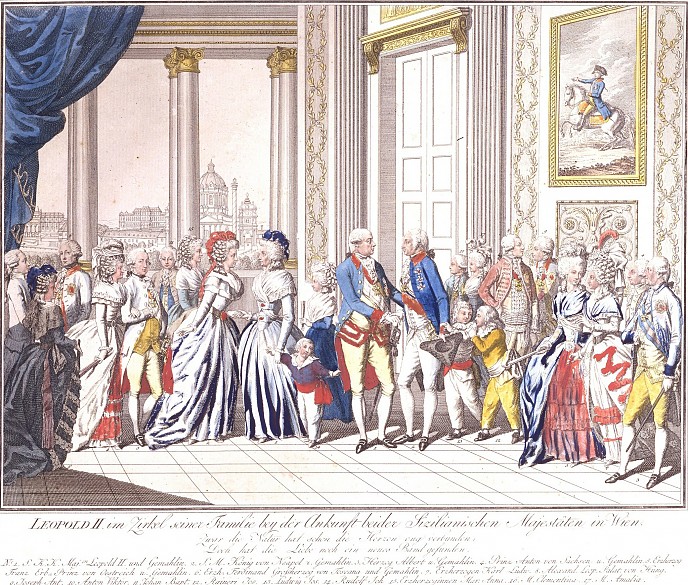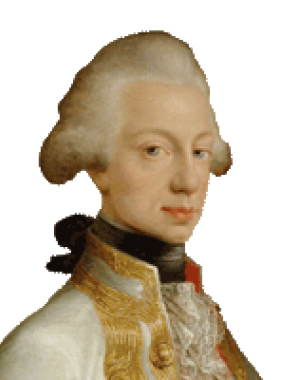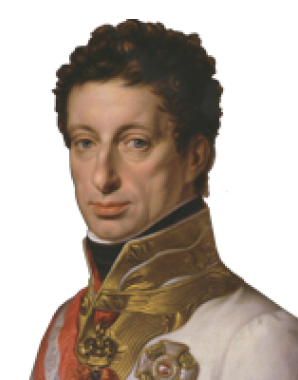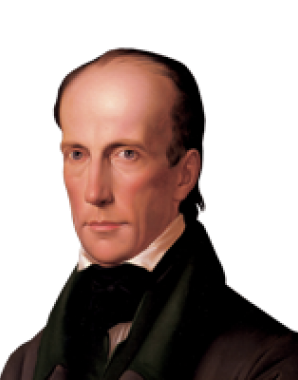‘A splendid populator’ – Leopold II and his large family
As a father, Leopold proved to be a true son of Maria Theresa. Like his mother he had 16 children. Leopold and his wife Maria Luisa are the progenitors of several lines of Habsburgs.
Maria Luisa (1745–1792) was the daughter of the Bourbon monarch Charles of Naples and Sicily, who ascended the Spanish throne as Charles III in 1759. While still a small child, Maria Luisa was promised to a prince of the Habsburg-Lorraine dynasty. This was in keeping with the renversement des alliances, the new alliance policy pursued by Maria Theresa which aimed at rapprochement between the houses of Habsburg and Bourbon, traditional arch-enemies in the struggle for supremacy in Europe. To reinforce the treaties the children on both sides were betrothed to one another. Originally Karl Joseph, Maria Theresa’s second son, had been intended for this union, but when he died at a young age this important match was not abandoned, with the next-born son, Leopold, moving up to take his late brother’s place.
The wedding took place in Innsbruck in 1765 but was overshadowed by the sudden death of the bridegroom’s father, Franz Stephan of Lorraine.
Constant childbearing aged Maria Luisa rapidly. Described as rather unprepossessing in appearance and colourless in character, she accepted her husband’s affairs with resignation. It is alleged that she even befriended her husband’s long-term mistress, a dancer called Livia Raimondi. Maria Luisa died only a few months after her husband and was interred beside him in the Imperial Crypt in Vienna.
The grand duchess bore her husband sixteen children within 21 years, and it is assumed that she also suffered at least three miscarriages. Maria Luisa is thus one of the most fecund and prolific of Habsburg wives. This wealth of children led to Joseph giving his brother the ironic nickname of the ‘splendid populator’.
In addition to three children who died in infancy the following members of the dynasty issued from this marriage.
Their firstborn child was a daughter, Maria Theresia (1767–1827), who was married to Prince Anton Clemens of Saxony. She died shortly after her husband had ascended the throne of Saxony.
Their eldest son Franz II (I) (1768–1835) continued the principal ruling line of the dynasty.
The next son, baptized Ferdinand (1769–1824), succeeded his father as Grand Duke of Tuscany, ruling as Ferdinand III. His descendants formed the Tuscan branch of the Habsburg dynasty, which still exists today.
The next daughter, Maria Anna (1770–1809), never married and became princess-abbess of the Theresian Chapter at the Hradschin in Prague.
Karl (1771–1847) achieved fame for his defeat of Napoleon at the battle of Aspern. He was later adopted by Leopold’s childless sister Marie Christine. As heir to her huge fortune (including the collection of art that would later be known as the Albertina) he founded the Teschen line of the dynasty, named after the Duchy of Teschen in the Austrian part of Silesia held by this collateral branch as a feoff of the Bohemian crown.
Alexander Leopold (1772–1795) became palatine or governor of Hungary. He died without issue.
Josef Anton (1776–1847) founded the Hungarian line of the Habsburg dynasty and succeeded his elder brother Alexander Leopold as Palatine of Hungary, a title that became more or less hereditary among his descendants. Josef Anton rendered great services to Hungary and was an extremely popular figure. Josef’s son Stefan Viktor (1817–1867) followed his father in office and attempted to play a mediating role between the imperial dynasty and the revolutionaries during the Hungarian war of independence in 1848/49. His pro-Hungarian views eventually made him persona non grata at the imperial court and he died in exile in Germany. Descendants of this branch of the dynasty were to play a not inconsiderable role in Hungarian politics even after the fall of the Monarchy.
Leopold’s daughter Maria Klementine (1777–1801) married Crown Prince Francesco of Naples and Sicily but died at the age of only twenty-three.
Another son called Anton Viktor (1779–1835) embarked on a career in the Church. Originally destined to become archbishop and prince elector of Cologne, from 1805 he was invested with the office of Grand Master of the Teutonic Order. The archduke distinguished himself as a generous patron of the sciences and arts. He became a patron of the Musikverein in Vienna and an honorary member of the Academy of Sciences. In his private life he was an enthusiastic gardener and botanist.
Another dynastic line developed from the morganatic union of the ‘Styrian prince’, Archduke Johann (1782–1859) and Anna Plochl. The descendants of this Habsburg bear the title of Counts of Meran but are not regarded as Habsburgs in a genealogical sense.
Rainer (1783–1853), who acted as viceroy of the Habsburg kingdom of Lombardy-Venetia from 1817 to 1848, founded yet another collateral line which was however only short-lived.
Ludwig (1784–1853) embarked on a military career. On the one hand this Habsburg was an enthusiastic promoter of industrialization and modernization in the Austrian Empire, but on the other he was also a staunch representative of the neo-absolutist and rigidly dynastic tendency within the imperial family. After the death of his elder brother Emperor Franz I in 1835, Ludwig was appointed head of the State Conference formed to govern the empire for the feeble-minded Emperor Ferdinand, who was incapable of ruling by himself. A hated symbol of the Metternich system that was increasingly sinking into stagnation and backwardness, he resigned during the revolution of 1848.
Rudolf (1788–1831) was also initially destined for a military career, but later entered the Church for reasons of health: he suffered from epilepsy and had a generally weak constitution. In 1805 the see of Olmütz (Olomouc) was held out in prospect for him, and in 1820 he was installed as archbishop. He became a cardinal in 1819.
However, it was as the patron of Ludwig van Beethoven that Archduke Rudolf would go down in history. Rudolf was a gifted pianist and took lessons from Beethoven, who became a good friend. Together with a group of aristocrats he arranged for the payment of an honorary pension to the composer in order to ensure that he remained in Vienna.
In 1814 Rudolf became a patron of the Gesellschaft der Musikfreunde (also known as the Vienna Musikverein), leaving his extensive collection of musical instruments and scores to this major institution of musical life in the imperial capital on his death at the age of only forty-three.
















